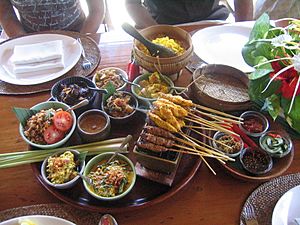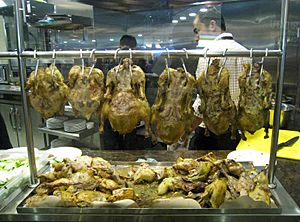Balinese cuisine facts for kids
Balinese cuisine comes from the beautiful island of Bali. It uses lots of different spices, fresh veggies, meat, and fish. It's part of Indonesian cuisine, but it also has its own special traditions. You can see influences from Chinese and Indian cooking too.
Most people in Bali are Hindu. Their food traditions are a bit different from the rest of Indonesia. During festivals and religious celebrations, many special foods are made. These foods are offered to the gods and then shared by everyone.
Rice is the main food and is eaten with almost every meal. People in Bali eat a lot of pork, chicken, fruits, vegetables, and seafood. However, because most Balinese are Hindu, they rarely eat beef.
Bali is a very popular place for tourists. There are many cooking schools where you can learn to make Balinese dishes. You can also find local treats at night markets, warungs (small food stalls), and from fruit sellers.
Contents
What Ingredients Are Used?
Steamed rice is a big part of every meal. People eat a lot of pork, chicken, seafood, and vegetables. But, as mentioned, Balinese people rarely eat beef because of their Hindu beliefs.
Balinese cooking uses many spices. These include Kaempferia galanga (a type of ginger), shallots, garlic, turmeric, ginger, and Kaffir lime. A special mix called "Balinese 8-spice" includes white pepper, black pepper, coriander, cumin, clove, nutmeg, sesame seed, and candlenut. Other important ingredients are palm sugar, fish paste, and basa gede (a special spice paste).
Bali also has many delicious fruits. Some popular ones are rambutan, mangoes, mangosteen, bananas, jackfruit, passion fruit, pineapple, salak (snake fruit), papaya, melon, oranges, custard-apple, coconut, and durian.
How Food Is Served
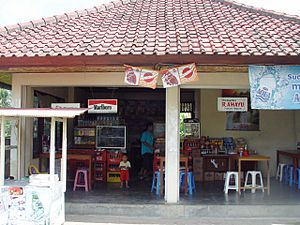
In Hindu Balinese traditions, some foods are used in religious ceremonies. They are offered to the gods. People believe certain foods are best for certain gods. For example, ducks are often offered to Hindu gods like Brahma.
Balinese families usually buy fresh ingredients from the local market each morning. They cook the food in the late morning to eat for lunch. Any leftovers are saved and heated up for dinner. Besides homemade meals, you can find Balinese food everywhere. From small street carts and warungs to fancy restaurants in hotels. Small family-run warungs are great for trying local food without spending too much.
Some warungs or restaurants specialize in just one type of dish. For example, some only serve babi guling (roast pig), bebek betutu (crispy duck), or nasi campur (Balinese mixed rice).
Rice in Bali
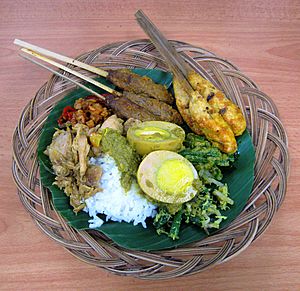
Bali has a long history of growing rice. They have an amazing old system called Subak to water their rice fields. The Balinese water temples help manage how water is shared among the villages. In Balinese Hinduism, Dewi Sri is a very important goddess of rice. During religious ceremonies, colorful statues of her and other gods are often made from sticky rice.
Spices and Seasonings
Basa gede, also known as basa rajang, is a special spice paste. It's a main ingredient in many Balinese dishes. It forms the base for many flavors. Its ingredients include garlic, red chili peppers, Asian shallots, nutmeg, ginger, turmeric, palm sugar, cumin, shrimp paste, and salam leaves (like an Indonesian bay leaf).
Balinese dishes often use basa genep. This is a typical Balinese spice mix used for many curry and vegetable dishes. It's also used to marinate meats. Tabia lala manis, a thin soy sauce with chili peppers, and sambal matah are popular sauces served with meals.
Popular Dishes
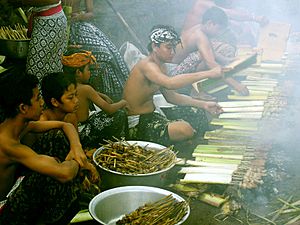
Some famous Balinese foods include:
- Lawar: A mix of chopped coconut, garlic, and chili pepper, often with pork or chicken meat.
- Bebek betutu: Duck stuffed with spices, wrapped in banana leaves and coconut husks, then cooked slowly in a pit.
- Balinese sate (sate lilit): Spiced minced meat pressed onto skewers. These skewers are often lemongrass sticks!
- Babi guling (celeng guling): A whole roasted pig stuffed with chili peppers, turmeric, garlic, and ginger.
In Bali, mixed rice is called nasi campur Bali or just nasi Bali. This mixed rice might have grilled tuna, fried tofu, cucumber, spinach, tempe, vegetable curry, corn, and chili sauce, all served on a bed of rice. Mixed rice is often sold by street vendors, wrapped in a banana leaf.
Betutu is a roasted chicken or duck dish with lots of spices. Lawar is a traditional vegetable and meat dish served with rice. It often includes shredded unripe jackfruit and young banana flower. Babi guling is a delicious Balinese-style roast pork.
You can also find other common Indonesian dishes like tempe and tofu. Different kinds of Sambal (chili sauces) are also popular. Bakso, which are meatballs, can also be found.
List of Dishes to Try

- Betutu: Steamed or roasted chicken or duck with lots of seasoning. A special dish from Bali.
- Babi Guling: Roasted suckling pig, very famous in Bali.
- Iga Babi: Balinese pork ribs.
- Sate Babi: Pork satay.
- Sate Lilit: Spiced minced meat on a stick.
- Soto Babi: Pork soup.
- Lawar: Mixed vegetables, minced meats (pork or chicken), and spices. There are white and red versions.
- Jukut Urab: Balinese mixed vegetables (like a salad) with grated coconut.
- Tipat Cantok: A Balinese salad with peanut sauce. It has tipat (rice dumplings), vegetables, and tahu (tofu).
- Nasi Bali: Rice served with various side dishes.
- Nasi Jinggo: A small portion of rice with different dishes, often wrapped in banana leaves. It's a popular breakfast or late-night snack.
- Basa Genep: The main Balinese spice mix used for chicken, fish, or meat.
- Sambal Matah: A "raw" chili sauce with minced garlic, onions, chili peppers, lime, and lemongrass, mixed with coconut oil.
- Sambal Bongkot: A Balinese chili sauce made with Torch Ginger.
- Sambal Embe: A Balinese chili sauce made from sautéed garlic, onions, chili peppers, salt, and terasi (shrimp paste).
- Urutan: A traditional Balinese pork sausage.
- Laklak: A traditional Balinese little pancake with grated coconut and melted palm sugar.
- Bubuh Sum-Sum: Rice porridge with palm sugar sauce and grated coconut.
- Bubuh Injin: Black sticky rice with grated coconut and melted palm sugar.
- Bantal: Packages of sticky rice, coconut, sugar, and fruit (often bananas) wrapped in leaves.
- Sumping Waluh: Steamed cakes made from rice flour and pumpkin, wrapped in banana leaves.
- Sumping Biu: Steamed cakes made from rice flour with banana inside, wrapped in banana leaves.
- Kopi luwak: Also called civet coffee. It's made from coffee beans that have been eaten and then passed by a small animal called a civet. The beans are then collected, cleaned, and roasted.
Drinks
Balinese coffee, called Kopi Bali, and hot tea, teh panas, are very popular. Tea is often served with sugar and condensed milk.
Brem is a Balinese rice wine. It's an alcoholic drink made from fermented black or white glutinous rice.
See also
 In Spanish: Gastronomía de Bali para niños
In Spanish: Gastronomía de Bali para niños


